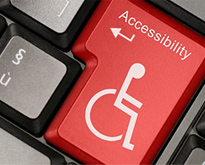Last Updated on March 6, 2024
Most people whom surf the web take it for granted; however, people with disabilities and impairments often feel it can be an inhospitable place to visit.
Disabilities affect 750 million people worldwide and three out of every 10 families are touched by a disability in some way. In the US, one in five people have a disability and one in 10 has a severe disability – that’s approximately 54 million Americans.
So what should designers implement, to help their website become more accessible?
The Web Accessibility Initiative (WAI) has developed guidelines and techniques, describing accessibility solutions for software and Web developers. The WAI guidelines are now considered the international standard for Web accessibility, ensuring the vital aspects of accessibility are always in place.
Screen Reader Considerations

Just because a person cannot see, does not mean they aren’t as impatient as most sighted users. Just as sighted users don’t always read every word on a page, those using screen readers don’t always want to listen to every word either. In fact, they often scan with their ears, taking in enough relevant information to decide whether to continue listening. Where a sighted user would find a keyword scanning the page, a visually impaired user may not catch that keyword if it’s not near the start of a link or a line of text.
Other methods include using hidden text for certain headings such as site navigation and skip links. It’s also vital to use concise, bold and descriptive link text – using text like ‘click here’ or ‘more’ is frowned upon and it’s bad for accessibility as well as general usability.
When using images, ensure they have their information attached using ALT text – this allows the screen reader to read out the description of them.
Place the main content of each web page before the navigation in the mark-up HTML – this ensures a visually impaired user can determine whether they want to stay on the page, without having to hear the navigational properties of the page. Also, provide a ‘skip to navigation’ link – this is far better than putting the navigation before the content and providing a ‘skip to content’ link.
Partially Sighted Users
For users with sight problems, ensure that text can be resized, with a link to information on how to resize. Using descriptive link text is a good practice, as partially sighted users tend to browse pages by tabbing from one link to the next.
Breaking up the content of the web page into small paragraphs not only helps the partially sighted, but also a fully sighted person. Reading a long paragraph of text from a screen is hard work on the eyes, so inserting sub-headings and lists improves usability all round.
Screen Magnifier
Avoid using the text embedded function within images when images are to be used by a screen magnifier, as the text will appear blurry and pixelated when magnified.
Also, use large headings for HTML: H1, H2, H3, H4.
Deaf And Hard Of Hearing Users
Any audio content on a website should be accompanied by subtitles or a written transcript. This is also beneficial for able-bodied users, as an audio description allows the user to quickly determine if they want to download the content or not.
Learning Difficulties
Ensuring a consistent look throughout your website is not just common practice in designing a stylish site, but people with learning difficulties also benefit as each page should hopefully function in a similar way. You should generally try to avoid using overcomplicated words, words in their non-literal sense or abstractions. Always use concise signposted summaries of each page at the top of the page.
If a user finds themselves on a page too advanced or above their reading abilities, ensure you provide a link that can take them back to a page of simpler content.
These are the areas of accessibility that should be a basic starting point for all websites, before aesthetics are fleshed out. Ensuring you meet the WAI guidelines will ensure a disabled user’s web experience is satisfying, rather than a frustrating time spent sifting through the information they need. It is worth remembering that web accessibility should not be seen as a design chore, as if managed effectively, it should provide you with many more site visitors than you might have otherwise achieved.

